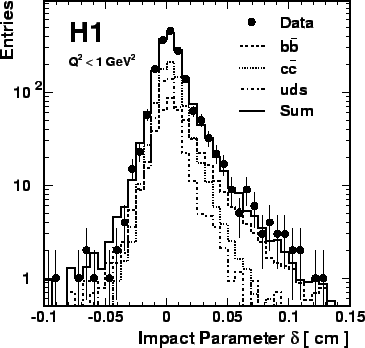 |
 |
In many analyses, a complete reconstruction of the heavy hadron invariant mass and/or displaced vertex is not possible - nor is it necessary, as the partial reconstruction and identification of event characteristics that signify the presence of heavy quarks, e.g.the presence of a leading lepton or decay lifetime distributions, is often sufficient for the measurement of heavy quark production cross sections and event distributions. The main advantage of those measurements in which heavy hadrons are only partially reconstructed, is that they can be performed on samples of much larger statistics. For example, in more recent measurements, the measured lifetime distributions have been used to determine the fraction of events containing charm and beauty (see section 5.5.2). For these measurements it is sufficient to measure at least one charged decay particle track in the silicon detectors from which the lifetime information is extracted.
The reconstruction of secondary detached vertices is experimentally
demanding. An unambiguous association of all tracks to the
secondary vertex can only be achieved if the spatial
precision of the track measurement is of the same order as the
distance between the primary and the secondary vertex,
i.e.
![]() .
Harsh track selection cuts are necessary to ensure that
the tracks fulfill this criterion, leading to a significant
loss of statistics.
For quantitative analyses of heavy quark
production rates, e.g.cross section measurements,
the loss of signal events due to lifetime-based selection cuts
needs to be precisely estimated.
This would require to precisely describe the
track reconstruction efficiencies and the spatial resolutions
of all tracks used for the reconstruction of the heavy hadron.
.
Harsh track selection cuts are necessary to ensure that
the tracks fulfill this criterion, leading to a significant
loss of statistics.
For quantitative analyses of heavy quark
production rates, e.g.cross section measurements,
the loss of signal events due to lifetime-based selection cuts
needs to be precisely estimated.
This would require to precisely describe the
track reconstruction efficiencies and the spatial resolutions
of all tracks used for the reconstruction of the heavy hadron.
In recent analyses of the H1 Collaboration,
a simpler method has been successfully used,
which is based on the measurement of the impact parameters
of one or several tracks, and thus allows to maintain a larger number of
signal event candidates than the secondary vertex method.
In the impact parameter method, only a subset of the
tracks originating from the displaced vertex is used to perform
a lifetime tag.
The impact parameter of a track is defined as the transverse distance
of closest approach (DCA) of the track to the primary vertex point.
The signed impact parameter ![]() (fig.15)
of the charged particle track with respect to the primary event vertex reflects
the lifetime of the particle from which the charged particle decays.
The signed impact parameter is defined by reference to the direction
of the reconstructed particle or the jet to which the track is associated.
Usually, the direction is reconstructed using a jet algorithm (see above).
The signed impact parameter of a track is defined as positive if the
angle between the jet direction and the line joining the primary
vertex to the point of DCA is less than
(fig.15)
of the charged particle track with respect to the primary event vertex reflects
the lifetime of the particle from which the charged particle decays.
The signed impact parameter is defined by reference to the direction
of the reconstructed particle or the jet to which the track is associated.
Usually, the direction is reconstructed using a jet algorithm (see above).
The signed impact parameter of a track is defined as positive if the
angle between the jet direction and the line joining the primary
vertex to the point of DCA is less than
![]() , and
it is defined as negative otherwise
(see fig.15).
The sign allows to statistically disentangle detector resolution effects
and effects from the decay lifetime of the heavy hadron.
Tracks from the decays of long lived particles will have positive
impact parameters, if resolution effects are neglected.
Tracks produced at the primary vertex result
in a symmetric distribution around 0, i.e.negative impact parameters
predominantly result from detector resolution effects.
, and
it is defined as negative otherwise
(see fig.15).
The sign allows to statistically disentangle detector resolution effects
and effects from the decay lifetime of the heavy hadron.
Tracks from the decays of long lived particles will have positive
impact parameters, if resolution effects are neglected.
Tracks produced at the primary vertex result
in a symmetric distribution around 0, i.e.negative impact parameters
predominantly result from detector resolution effects.
Figure 16 shows the distribution of the
impact parameter of an identified muon track for a sample of photoproduction
events with two or more jets and a muon [44].
In this sample the contribution from heavy quarks
is enhanced by the requirement that a muon with transverse momentum
![]() GeV be present.
The lifetime effects are apparent in the asymmetric distributions of
the estimated charm and beauty contributions.
The normalization of the contributions has been determined by
a fit to the data. Details of this analysis are described in
section 6.2.1.
GeV be present.
The lifetime effects are apparent in the asymmetric distributions of
the estimated charm and beauty contributions.
The normalization of the contributions has been determined by
a fit to the data. Details of this analysis are described in
section 6.2.1.
 |